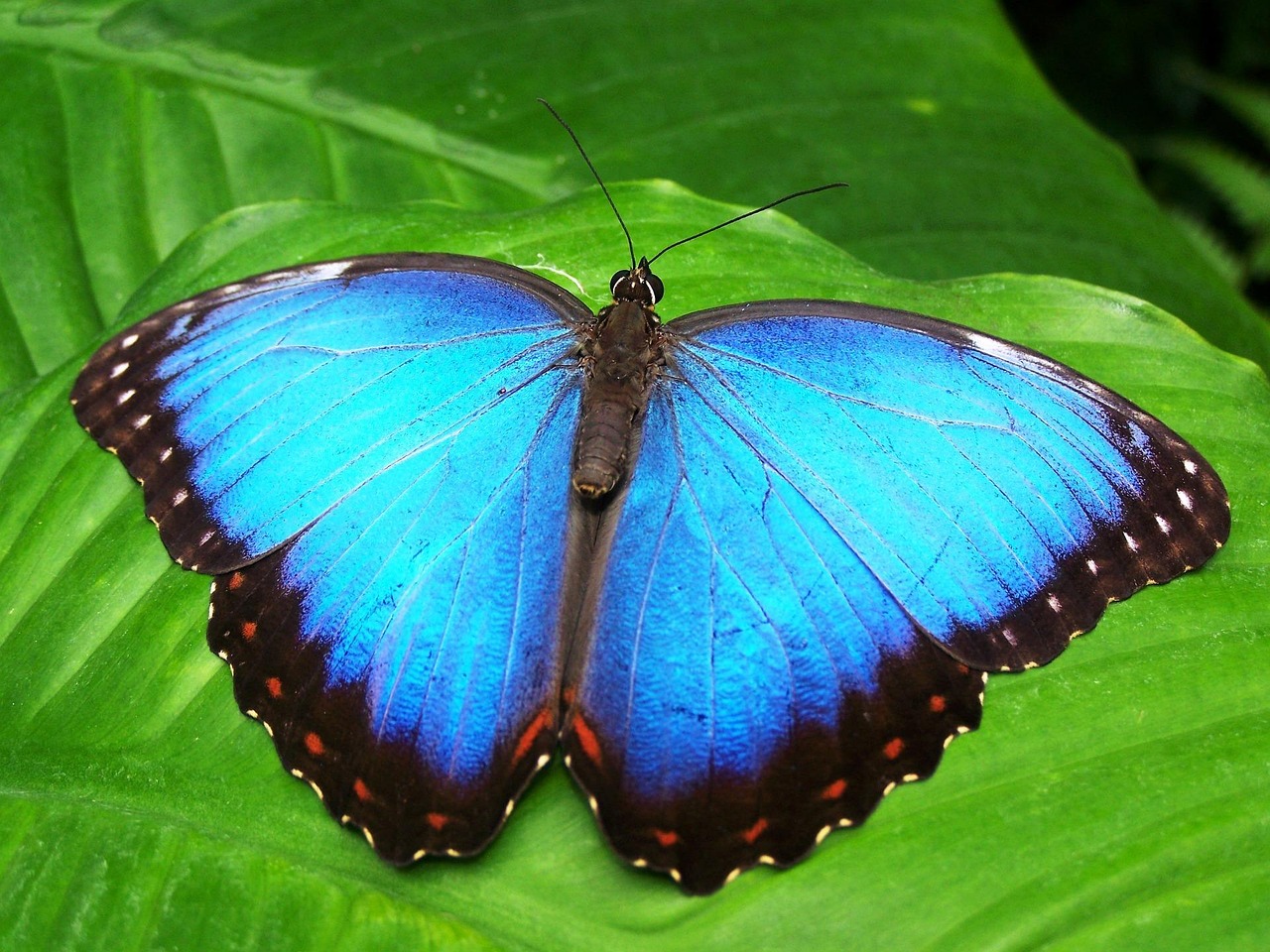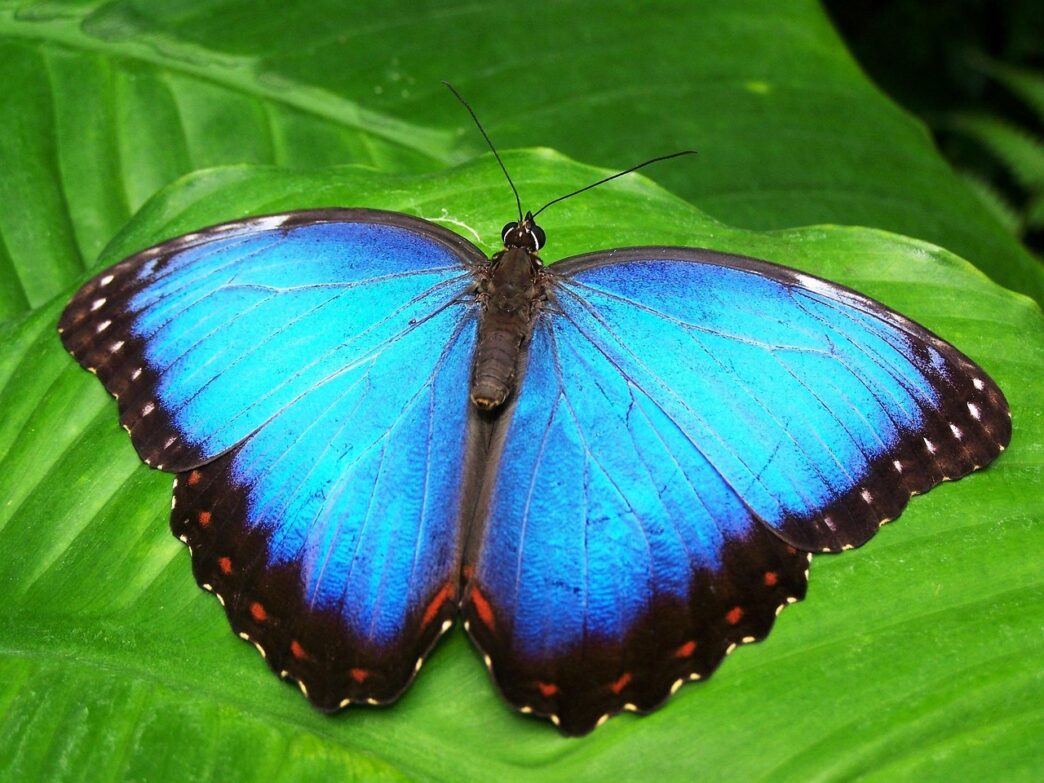
Costa Rica’s biodiversity is a global standout, and the Morpho butterfly is one of its most iconic residents. Named a national symbol in 2022, the Morpho helenor narcissus is celebrated for its shimmering blue wings and deep ties to the country’s culture, ecology, and conservation efforts. This post explores the butterfly’s traits, its role in Costa Rica, and how you can experience it firsthand.
What Makes the Morpho Special
The Morpho helenor narcissus, often called the Blue Morpho, is one of over 1,200 butterfly species in Costa Rica, which hosts 18% of the world’s butterflies despite covering just 0.3% of Earth’s surface. Its wings, spanning 5 to 8 inches, flash a brilliant blue—not from pigment but from microscopic scales that refract light like prisms. This iridescence makes males especially eye-catching as they compete for mates, while females are often duller, with brownish tones. The underside of the wings is a camouflaged brown with eye-like spots to deter predators.
Morphos live for about 115 days, starting as eggs on host plants like Machaerium. Caterpillars, reddish-brown with green patches, feed voraciously and can irritate human skin with prickly hairs or a rancid-smelling fluid if disturbed. After forming a jade-green chrysalis, they emerge as adults, feeding on liquid diets like rotting fruit, tree sap, or fungi through a straw-like proboscis. Their flight is erratic, with a float-and-fall pattern that confuses predators, often seen along forest edges, rivers, or sunny clearings.
These butterflies thrive in Costa Rica’s rainforests, from sea level to 1,800 meters, in places like Monteverde, Guanacaste, and the Caribbean coast. Their presence signals a healthy ecosystem, as they rely on pristine habitats. You can spot them most easily in the early morning, when males are active, or late morning for females. Photographers beware: Morphos often close their wings when resting, hiding their blue brilliance.
The Morpho’s Role in Costa Rica
The Morpho butterfly grabs attention with its striking appearance and fascinating biology. This section breaks down what sets it apart, from its shimmering wings to its life cycle, and why it thrives in Costa Rica’s vibrant ecosystems.
Cultural Significance
Indigenous groups like the Boruca and Maleku revere the Morpho as a symbol of transformation and rebirth, reflecting its metamorphosis. Its blue hues inspire their art—masks, textiles, and baskets—sold in markets and used in traditional dances and ceremonies. Some tribes see Morphos as spiritual guides, while others, using their toxins for poison darts, view them as powerful spirits. This reverence ties the butterfly to Costa Rica’s heritage of respecting nature.
Ecological Importance
Costa Rica’s biodiversity—5% of the world’s species—relies on healthy ecosystems, and Morphos are key players. As pollinators, they help plants reproduce, supporting rainforest diversity. Their caterpillars feed on specific plants, linking them to forest health.
A thriving Morpho population indicates robust conservation, with over 25% of Costa Rica’s land protected. However, rare species like Morpho amathonte face threats from deforestation, highlighting the need for ongoing efforts.
Economic Impact
Since the 1980s, butterfly farming has boosted Costa Rica’s economy. A Peace Corps volunteer, Joris Brinckerhoff, pioneered the export of Morpho pupae, now a $2 million industry supporting over 400 families. These farms preserve habitats while supplying zoos and exhibits worldwide. The Morpho’s image also drives ecotourism, with visitors flocking to see them in the wild or at conservatories. Local artisans sell butterfly-themed crafts, from jewelry to fabrics, further tying the Morpho to sustainable livelihoods.
Where to See Morphos
Costa Rica offers prime spots to observe Morphos:
- La Paz Waterfall Gardens: A butterfly enclosure for close-up views.
- Monteverde Cloud Forest Reserve: Ideal for wild sightings along trails.
- La Selva Biological Station: A research site with rich butterfly diversity.
- Butterfly Conservatory in La Fortuna: Guided tours explain the life cycle.
Visit early morning or late afternoon near rivers or sunny forest edges. Guided tours at conservatories or national parks like Tortuguero enhance the experience, offering insights into conservation. Be patient—Morphos are quick and often hide their blue wings when perched.
Conservation Efforts
While Morphos are abundant, habitat loss threatens some species. Costa Rica’s national parks and reserves, supported by ecotourism, protect their habitats. Butterfly farms reduce wild collection, and organizations like GVI offer volunteer programs to monitor populations and promote sustainable practices.
The 2022 law declaring the Morpho a national symbol tasks the Ministry of Environment and Energy with conservation and the Tourism Institute with promoting its image, reinforcing Costa Rica’s commitment to biodiversity.
The Morpho butterfly embodies Costa Rica’s dedication to nature, culture, and sustainability. Its wings are a call to protect the planet’s ecosystems. Whether you’re hiking in Monteverde or exploring a conservatory, spotting a Morpho is a highlight you won’t forget.

